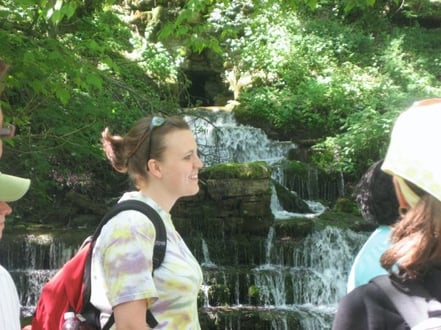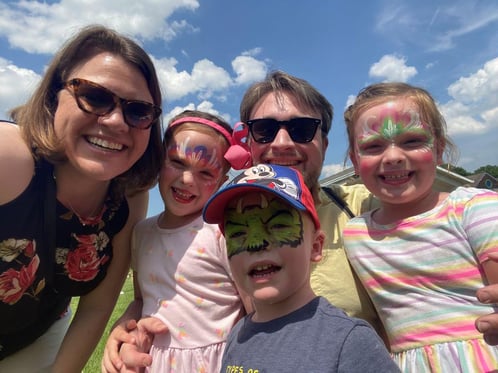Practical Activist Features Andrea Longton, Social Justice Investor & CDFI Champion
- Bluestone Staff
- March 15, 2023
Andrea Longton is Senior Vice President, Development and Capitalization at Opportunity Finance Network, the leading network of community development financial institutions (CDFIs). A professional Social Justice Investor and a CFA Charterholder, Andrea has raised over $500 million for low-wealth communities in America. She’s also the co-host of "Renegade Capital: The Activist's Podcast for Finance and Investments," and is on a mission to wrench open the floodgates of private capital to flow freely into people and places historically disconnected from mainstream financial resources.
Here are some highlights of our recent conversation with her:
Q: Where did your passion for social justice investing and finance begin?
A: My passion for affordable financing and social justice investing grew out of the belief that every person deserves access to basic financial tools that anyone needs to reach their full potential. My lightening rod moment – at least in my professional career – occurred a few years into my first-ever, full-time job as a financial analyst at a consulting firm that raised capital for development projects in emerging markets.
While I had been busy raising money for renewable energy projects in sub–Saharan Africa and telecom infrastructure in the Middle East, I had blinded myself to the financial realities of low-wealth people living in the United States.
 Photo left: Andrea in Appalachia
Photo left: Andrea in Appalachia
The blindfold fell away when I visited family in Appalachian Kentucky, a place my mother calls home, and where I have fond childhood memories of minnow fishing with my cousin and launching rocket ships from the middle school parking lot.
But now, I could see beyond the joy of visiting my grandparents to notice the physical realities of day-to-day living in a community characterized by persistent poverty.
Driving past the blue-tarped roofs and a high school crumbling in on itself, I suddenly realized that conditions on the ground where my grandparents still lived were the same as, if not worse than, conditions on the ground in the countries where I was driving capital.
I ran into my shock like it was a brick wall.
When I returned to work, I couldn’t focus on international markets. Not when there was so much work to do in my own backyard. I started researching career opportunities that created financial resources for low-wealth communities in the US and was lucky enough to find a nearby CDFI pursuing mission-based lending: Capital Impact Partners in Arlington, Virginia.
I had stumbled into a once-in-a-lifetime career opportunity when Ellis Carr hired me as an analyst for his team. Leading social justice investors taught me how access to affordable financing can transform communities. It was a masterclass of best practices for social justice investors. I absorbed every insight I could glean: how to capitalize a balance sheet, what makes a good loan, how to listen to communities for investment insights, and how to create financial products designed for community impact.
Q: Tell us the spark behind the Renegade Capital Podcast and the Social Justice Investor web site?
 A: Both snowballed out of an idea born in a windowless conference room in a Chicago hotel in January 2020. Finance leaders from about 40 CDFIs and all the federal home loan banks had convened to ask: how do we get better money and more money into CDFIs?
A: Both snowballed out of an idea born in a windowless conference room in a Chicago hotel in January 2020. Finance leaders from about 40 CDFIs and all the federal home loan banks had convened to ask: how do we get better money and more money into CDFIs?
One leader from the federal home loan banks stood on the stage and explained how – and I’m paraphrasing here – “We can either invest in banks or invest in CDFIs. Since we have a lot of data on banks, especially about what happens when they go bankrupt, we feel comfortable with how much of our money we’d be able to recover if they end up in bankruptcy court. But since CDFIs don’t have a track record going bankrupt, we don’t have data to backstop how much money we’d recover if they end up in bankruptcy court. Since we don’t have that data, we feel like it’s less risky to invest in a bank instead of a CDFI.”
No matter how much you think about that statement, you won’t find a shred of common sense. You’d have to transform into Alice and go through the Looking Glass to understand the logic.
Sitting in that room, staring at the stage with my mouth wide open, was a galvanizing moment for me.
A lightning bolt hit. I realized we have to change the narrative about investing. We have to move the needle and demonstrate how finance is a tool to create the world in which we want to live.
I admit, I stopped listening to the rest of the conversations around me. I opened my notebook and started writing a new narrative that I now think about as “social justice investing.” I define social justice investing in terms of its dual objectives: sustainable financial earnings coupled with social justice returns.
Two months later, we all watched in horror as the economy ground to a screeching halt. I still pushed ahead with the website and later came together with Leah Fremouw and Ebony Perkins to create the Renegade Capital podcast. We’re finishing up our second season, and it’s been great for us to listen to and learn so much from so many people and get their stories and share those stories in ways that make the conversation accessible and interesting.
We want to show the vibrancy behind financing and how investing can make real impact. We want to show the robust and rich fabric that are the stories of people and communities. We’ve learned over and over again that finance is simply a tool; it’s people that shape what it does and what it ultimately looks like when it shows up in the world.
Editor’s note: Andrea’s book, Social Justice Investing: How to Build Wealth and Advance Social Justice, is slated to publish in 2024. She describes it as “part Investing 101 and part Chicken Soup for the Soul.”
Q: Have you had any major revelations when you look at the events of the last few years through the lens of social justice?
A: The past few years have been ripe with revelations. The biggest one is how justice can only be found in self-determination.
Investing in justice means giving impacted communities the resources they need for success (like affordable financing) and then getting the heck out of the way. Let communities create their own plan for success and then underwrite loans that mitigate risks while empowering community leaders.
Trust me, no one has ever needed my advice on how to use the financing. Instead, I’ve learned time and time again that the people who sit closest to the problems have the best insights to the solutions. I’m lucky enough to work among CDFIs who know how to maintain high-performing portfolios while advancing social justice.
Q: What would you like people to know or understand about CDFIs and social justice finance? (And how it is inextricably intertwined with environmental health?) Any myths you want to bust?
A: I will confess that I’ve recently been forced to look myself in the mirror and bust an incorrect myth about CDFIs.
As many people are noticing, the Biden Administration created a $27 billion opportunity to create a green, resilient economy. At least $8 billion of that funding is explicitly required to be allocated to low-income or disadvantaged communities.
Six months ago, I couldn’t have named a single green financing product that CDFIs offer. It just wasn’t something I had researched.
I’m sure you can imagine how embarrassed I was to learn that many CDFIs have been offering green financial products for years. They’ve been incredibly successful in layering resiliency underwriting criteria in mainstay mortgages and small business loans. Some have created solar panel financings for multi-family housing units. Other CDFIs finance energy efficient refrigeration systems for small businesses in the Appalachian county where my grandparents lived and where my journey into social justice investing first began.
So I’ve had the extremely humbling experience of busting my own myth. Or, as my family says – I had to eat a lot of crow while learning about the robust network of financing programs, products, and services quietly built out by forward-thinking and community-centric CDFIs.
 Q: Do you have a mantra or quote that you live by or that inspires you?
Q: Do you have a mantra or quote that you live by or that inspires you?
A: I love the Amanda Gorman quote: “For there is always light if only we are brave enough to see it, if only we are brave enough to be it.”
After hearing her poem, I now remind myself to “be the light.” After all, even if I can’t do everything, it doesn’t mean I can’t do anything.
The Practical Activist blog is created by Bluestone Life. Like CDFIs, creating positive impact is central to the work we do. At Bluestone, our life insurance empowers our customers to protect family, community and planet. A Certified B Corp and a member of 1% for the Planet, Bluestone is a transformative choice for social, environmental and financial systems change.
Meet other Practical Activists in the CDFI community that we’ve featured in our blog.
https://blog.bluestonelife.com/practical-activist-qa-featuring-tom-desimone-genesis-la
https://blog.bluestonelife.com/practical-activist-update-amir-kirkwood
https://blog.bluestonelife.com/practical-activist-qa-featuring-will-belongia
https://blog.bluestonelife.com/practical-activist-qa-lakota-vogel-four-bands-community-fund
https://blog.bluestonelife.com/practical-activist-qa-featuring-donna-molly-reinvestment-fund
Like hearing about Practical Activists?
We’ll share their stories with you monthly. (No email overload… we promise!)


